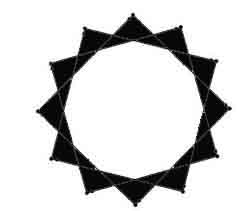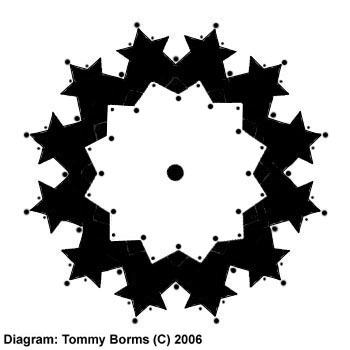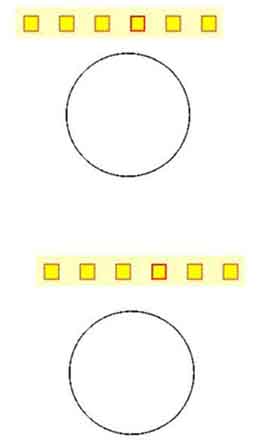| 9-19-06 - DREAM - I was in a large apartment, working on some kind of jewelry
project. A man sitting next to me on my left, reached out towards my hands with
his left hand up in
the air and then began to pick out plain silver rings from between my fingers and each on
had the word "Y a h r" (year?) on it. There were 5 of them.
Note: The German word for 'year' is 'J a h r e'. I have assume the five rings represent 5 years - either something is going to last five years, or will begin in five years. These rings were not pretty - they were like pieces cut off of a thick pipe - very plain. Five years from now is: September 19, 2011 9-20-06 - DREAM - I was with my husband in an apartment. He had just come home from prison and wasn't happy. He wanted to take all his meds with him on the road. I suggested to him that he only take the meds with him that he needed so that when he came back, he would still have meds left in the bottle and he or I wouldn't have to worry that he would lose them on the road somewhere. But he wanted to take all of them with him. (30 days worth) I then opened the closet door to get his things and suggested, "Why don't you just live your life one day at a time? And in the closet I saw in the air a 12 pointed star in a ring.
I woke up and heard the dog crying outside and remember yesterdays dream with the 5 rings, then fell asleep again. Interestingly, this crop circle appeared on July 8th, 2006 and was called to my attention after I told Joe Mason about the dream:
The 12 pointed star relates to astrology and the cycle of time - the 12 houses, what they mean and what they predict will happen during that cycle of time. See also: http://www.greatdreams.com/crop/2006ccs/2006ccs.htm for information about the 2006 crop circles and interpretations by Joe Mason At the moment of first breath, and at that particular place on earth we are born, all the heavenly bodies occupy a very precise position in the astrological chart; and our personal map of life's rhythms begin. The astrological chart associated with our personal moment of birth is called our natal chart, and this is the first tool of the astrologer. In the same manner, places, countries, and events being planned have their birth times and can be tracked astrologically as well. The signs are: The first house (Aries), the second house (Taurus), the third house (Gemini), the fourth house (Cancer), the fifth house (Leo), the sixth house (Virgo), the seventh house (Libra), the eighth house (Scorpio), the ninth house (Sagittarius), the tenth house (Capricorn), the eleventh house, (Aquarius) and the twelfth house, (Pisces).
The Cardinal signs are: the first house (Aries) the fourth house (Cancer)
The seventh house (Libra) and the tenth house (Capricorn). Esoteric astrology also sees the cosmos divided into four parts — Fourness, also known as the Four Elements. The ancient words defining the elements are: Fire, Earth, Air, and Water, and four triangles fit perfectly into the twelve houses. The Fire signs of the zodiac, are Aries, Leo, and Sagittarius. The Earth signs are: Taurus, Virgo, and Capricorn. The Air signs are: Gemini, Libra, and Aquarius
The
Water signs are: Cancer, Scorpio, and Pisces; Planets don't suddenly stop and begin moving in the opposite direction, but that is what they occasionally appear do within the astrological map. The planet Mercury is the closest to the sun, (about 58 million kilometers) and orbits the Sun about three times faster than the Earth (every 88 days). In the astrological chart, Mercury is never very far from the Sun. Mercury can never be farther than 28 degrees away. Mercury moves with the rest of the planets as it crosses the Sun on the back side, but as it continues to revolve around the Sun, it appears to move backward as it swings around and moves in front of the Sun; backing up in the astrological map. That's Mercury in retrograde. As it reaches the lower part of its orbit and once more begins its swing behind the Sun, it appears to change direction again. This natural cycle repeats about three times per year. Here is an example for 2006:
Here are the other retrograde planets:
9-20-06 - DREAM - I was in a restaurant and wanted to tell my dream about the five rings to another person and get an explanation. Before I could sit down, the restaurant people had to set up more tables because there were so many people there. So they set up two -round tables with white cloths on them that went all the way to the floor all around. then they brought chairs - 6 for each table, and set them up this way.
This happened very quickly. That was quickly apparent that was not going to work so they moved the chairs to this layout:
My friends arrived and before I told them my dreams, I told them about the tables being set up in 6 + 6 rings. Then a man on my left opened up a newspaper to the editorial page which shows a large cartoon in 3 pictures. In the cartoon #1, was a large swimming pool. In the pool were adults standing and talking at various random points and it showed children swimming around them in various ways, all going in a clockwise circle, very fast, and splashing the adults who were just standing there quietly. The 2nd cartoon showed a similar group of adults standing at various random points in a room, but again, in a clockwise movement, many children riding tricycles move around the people in the same way as the splashing swimmers had moved around the people in the pool, except the tricycles were going a little slower than the swimmers had. The 3rd cartoon also had the adults and children in them, but I didn't notice any movement at all in the picture so I pointed at the kids in the pool splashing and flailing there arms and legs around the adults and said, "That's what I dreamed yesterday." Just then, the waiter came to our table to get our order and said to me, "I have a twin who says he knows you." (The waiter was very short, blonde, blue eyed, and young. I wanted to ask him what his twin's name was, but he had moved on quickly. The woman to my right asked, "Who was that?" I said, "That's Mr. Hughes! We were going to hire him to be our gardener at our farm." Just then, a group of men in dark green uniforms with black collars on their jackets came walking into the restaurant. They were all carrying what looked like riding crops in their black gloved hands and rapping them on their gloves like the Gestapo were shown to us. It felt very ominous. |
|||||||||||||||||||||
| First, I need to explain the "Five rings" and the German connection: In the early 1600's, a samurai named Miyamoto Musashi, emerged from obscurity to mixing with the ruling class based solely on his undeniable skill in man to man combat. In a series of duels, he won against people that were thought unbeatable. At one time, using his two sword technique, he single-handedly beat over 30 samurai simultaneously attacking him with guns, arrows and swords. He wrote an analysis of his style in a book, The Book of Five Rings. Recently, the book has remerged as a reference and conversation point for modern Japanese and Western businessmen. It's strategies can be applied wherever there is conflict and competition occur. Like Sun Tzu's Art of War, it is written by someone with direct experience. In The Art of War, Sun Tzu recommended a strategic method to win that rarely required actual war. Spies, deception, and a correctly organised internal structure were his main tools. If it came to war though, he had detailed insight into its methods and strategies. The Art of War was written during China's Spring and Autumn period. This period could be likened to the pre-World War II Europe. Small dukedoms and kingdoms had been consolidated in previous conflicts. Only a few, large kingdoms remained in a state of tension with one another. There was peace, but everyone knew it wouldn't last. It didn't. Eventually wars broke out that lasted hundreds of years for what came to be called the Warring States Period. Nevertheless, for the time being there was peace and prosperity. Around this time, several philosophies were developed that later greatly influenced China and the world. Sun Tzu's book developed a life of its own, finding its way into the hands of Chinese General centuries after his death. These ideas were much discussed during the Spring and Autumn Period, but really came into their own during the following Warring States Period. The Rulers knew that the constant killing and war couldn't continue, but lacked the means to stop it. Eventually Confucianism and Sun Tzu came to the fore. It was a great combination because Confucius generally refused to speak on the issue of war claiming ignorance of it. Sun Tzu and other military thinkers filled the gap. Importantly, Confucius did not deny the occasional necessity of war, although, like Sun Tzu, he felt it was extremely undesirable. Around 500 BC the Art of War was written to educate and impress the nobility. It works. The book is expanded, possibly to 82 chapters. The original, 13 chapter version becomes a popular classic with Chinese leaders from the Warring States Period to Chairman Mao. It influences military and government policy. As recently as 1999, the Jiangsu Province Army Division built an Art of War park! In 1772, a French Jesuit discovers and translates the text. It it said to have become a favourite of Napoleon. In 1910, Lionel Giles, of the British Museum translates the book into English. This translation becomes popular, especially after the copyright runs out.In 1972 a large quantity of previously lost Art of War text is discovered in a tomb at Yin Chueh Shan, China. 1980's onwards: The Art of War gets mainstream exposure in movies like "Wall Street", "The Art of War", "Las Vegas" and "The Sopranos". THE BASICS: I. LAYING PLANS1. Sun Tzu said: The art of war is of vital importance to the State. 2. It is a matter of life and death, a road either 3. The art of war, then, is governed by five constant 4. These are: (1) The Moral Law; (2) Heaven; (3) Earth; 5,6. The Moral Law causes the people to be in complete 7. Heaven signifies night and day, cold and heat, 8. Earth comprises distances, great and small; 9. The Commander stands for the virtues of wisdom, 10. By method and discipline are to be understood 11. These five heads should be familiar to every
general: 12. Therefore, in your deliberations, when seeking 13. (1) Which of the two sovereigns is imbued with the
Moral law? 14. By means of these seven considerations I can 15. The general that hearkens to my counsel and acts 16. While heading the profit of my counsel, 17. According as circumstances are favourable, 18. All warfare is based on deception. 19. Hence, when able to attack, we must seem unable; 20. Hold out baits to entice the enemy. Feign disorder, 21. If he is secure at all points, be prepared for him. 22. If your opponent is of choleric temper, seek to 23. If he is taking his ease, give him no rest. 24. Attack him where he is unprepared, appear where 25. These military devices, leading to victory, 26. Now the general who wins a battle makes many Popular Quotes From and About the Art of War This news came out the following day after I had the dream: 8 German Warships Set Sail for LebanonSep 21, 9:52 AM (ET) By IMKE ZIMMERMANN
WILHELMSHAVEN, Germany
(AP) - Germany began its biggest naval operation
since World War II on Thursday as eight warships set
sail for the eastern Mediterranean to help the U.N.
keep the peace in Lebanon.
The first of the ships,
the frigate Karlsruhe, pulled away from the dock at
the North Sea port at Wilhelmshaven and moved
smoothly across the calm harbor after a farewell
ceremony.
The German force of two
frigates, two support vessels and four fast patrol
boats, along with three ships from Denmark, are to
arrive off the Lebanese coast in 10 to 14 days.
Defense Minister Franz
Josef Jung said the force would make a contribution
to peace by supporting the U.N.-brokered cease-fire
that ended Israel's monthlong war with Hezbollah
guerrillas.
"Unless the weapons are
silent there is no chance for peace in the Middle
East," Jung said at the ceremony.
Germany is taking charge of a multinational naval task force with a mandate to prevent arms shipments from reaching Hezbollah - a key component of the cease-fire agreement.
The naval detachment is
led by the 459-foot frigate Mecklenburg-
Parliament approved the deployment on Wednesday, although some lawmakers voted against it because of misgivings linked to Germany's Nazi past and the Holocaust.
Chancellor Angela
Merkel ruled out sending combat troops to Lebanon in
an attempt to ensure that no German soldiers could
get caught up in any confrontation with Israeli
forces.
Parliament approved a mandate allowing the deployment of up to 2,400 service personnel. Germany is also sending police and customs officers to advise and train Lebanese security forces on tightening border controls. |
|||||||||||||||||||||
|
NOTE: Again we have the apparent cycle of time shown to us in the previous dream, with the flailing arms and legs of the children going clockwise around the standing adults. Then we are shown the children again, going around and around clockwise on tricycles around the standing adults. Finally, the children become adults and everyone stands around and does nothing. Have they really progressed? I highly doubt it! One only has to study history to know that we don't learn from our mistakes. Joe Mason - my life partner received an e-mail right after I told him this dream. In the e-mail, it asks a question, "Is time really circular?" In this physical life, time seems to be linear - straight as an arrow - but that is an illusion - time is really circular. Events happen again and again - not necessarily to the same people, but the events return to haunt us in many different generations. OVERVIEW OF HINDU COSMOLOGICAL TIME CYCLES
To demonstrate the astronomical quantities which lie behind the cycles, we require only the principal unit of the cycles, namely, the kalpa period, and its three principal subunits: the manu, caturyuga, and kaliyuga intervals. In Hindu cosmogeny, all things proceed toward perfection in cycles of repeated incarnations. During the vast interval of one kalpa, the god of our solar system manifests all sentient creatures out of himself. Hindus call this a "day of Brahma". After this, the god of our solar system returns all sentient creatures to himself for the interval of one kalpa. Hindus call this a "night of Brahma". Traditional Indian textbooks on astronomy contain descriptions of Hindu cosmological time cycles as part of their general discussion of the divisions of time. Some scholars say there are two versions of the cycles, but the so-called Aryabhata (circa 500 A.D.) version is really slightly corrupted due to the fact that Aryabhata summed up the entirety of the time cycles in a single verse of his text, thereby leaving out essential details. In the Clark translation of the Aryabhatiya verse 3 we find:
The following three tables, taken from the English commentary to the Burgess translation of the SuryaSiddhanta, clearly present the infrastructure of Hindu cosmological time cycles. 1. In modern astronomy, a sidereal day is the interval of time between two successive passages of the Vernal point across the mid-heaven. During this interval, the Vernal point is affected by precession. A true revolution of the earth is a 360° rotation not affected by precession. FROM: http://www.aaronsrod.com/time-cycles/time-cycles-03.html
|
|||||||||||||||||||||
| Astrology
database
|
|||||||||||||||||||||
| DREAMS OF THE GREAT EARTHCHANGES
- MAIN INDEX
|
|||||||||||||||||||||



